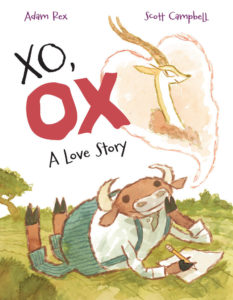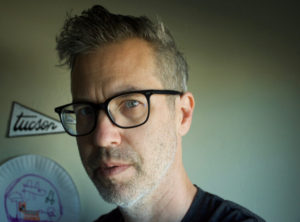 We always like to end the year strong, and thanks to December’s guest author interview, we’re doing exactly that. Welcome to Only Picture Books, Adam Rex!
We always like to end the year strong, and thanks to December’s guest author interview, we’re doing exactly that. Welcome to Only Picture Books, Adam Rex!
Now, it’s hard to imagine picture book writers and readers who don’t already know Adam’s work, but just in case some wildebeest or sentient meteor has come across this website, I’ll give some bio stuff. Because, like most folks, I have a soft spot for wildebeests and sentient meteors.
Adam is the author and illustrator of 40+ books for kids, including many OPB faves such as:
Other cool Adam-related things in no particular order:
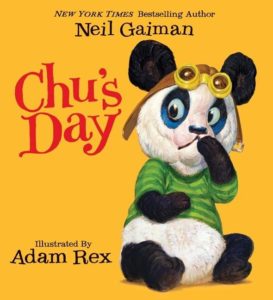 He’s worked with Neil Gaiman
He’s worked with Neil Gaiman- His work has been adapted for film and TV (the Dreamworks film Home was based on Adam’s novel The True Meaning of Smekday)
- He’s won awards like the Margaret Wise Brown Prize in Children’s Literature and the National Cartoonists Society Book Illustration Award
- He’s made art for Dungeons & Dragons and Magic: The Gathering
- He has (in order of smallest to largest) “a hermit crab, cat, dog, son, and wife”
Now that we’ve all been properly Adam Rexed, let’s hear from the man himself. Begin the interviewing NOW!
RVC: I’m always curious about how multi-talented people think about their talents. Are you a writer who draws, a drawer who writes, or something else entirely?
AR: I’m my mind I’m a writer and illustrator—I don’t prioritize one over the other. I guess I could combine those and tell people I’m a storyteller, but I don’t think anyone would know what I meant. Personally, when I hear that job title, I picture a retired guy wearing a jester’s hat.
RVC: Let’s reframe the question then. When did you first realize you were a maker of stories? And when did that go from being something you liked doing to something you could do as a career?
AR: I think I was always an illustrator, without knowing what that really meant until I was in college. Most kids are illustrators in some sense—most of them draw, and most kids who draw tell stories with their pictures. I’d decided at the age of five that I was going to be an artist when I grew up because I’d overheard my eight-year-old brother being upset that I was a better artist than him, and that seemed as good a reason as any to keep going. But writing didn’t really start being my thing as well until late high school.
RVC: What happened then?
AR: At that age, it clicked that the comics I liked and the picture books I’d been admiring at my part-time Waldenbooks job were made by actual living people and not famous figures who had been dead for a hundred years.
My mom found a place that sold original comic book art and she bought me a couple of X‑Men pages that I could go and compare to the printed pages in comic books I actually owned. All this made an outlandish future seem more real and attainable, so I think that’s when I settled into the idea that I was going to be a part of telling stories with words and pictures, somehow.
RVC: Since we’re roughly the same age, I’m going to superimpose my own experiences onto your life and assume that you, too, were playing a lot of games like Dungeons & Dragons, Magic: The Gathering, and maybe too many other video and tabletop games during those early years. How did playing games like those inform your future storymaking career?
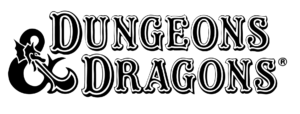 AR: Definitely a lot of D&D when I was younger. I think I started playing that around age ten and kept at it off and on for about ten years. And I always seemed to be the Dungeon Master, so that must have contributed to honing whatever storytelling chops I have—both in inventing plot on the fly and also trying to make each non-player character interesting. Thing is, I was the same kind of DM as I am a writer: I never planned enough and mostly just made it up as I went along. Only difference being that I didn’t get the chance to go back and rewrite all those shabby campaigns I put my players through.
AR: Definitely a lot of D&D when I was younger. I think I started playing that around age ten and kept at it off and on for about ten years. And I always seemed to be the Dungeon Master, so that must have contributed to honing whatever storytelling chops I have—both in inventing plot on the fly and also trying to make each non-player character interesting. Thing is, I was the same kind of DM as I am a writer: I never planned enough and mostly just made it up as I went along. Only difference being that I didn’t get the chance to go back and rewrite all those shabby campaigns I put my players through.
RVC: We’re going to circle back to your writing and revising process in a moment. But first, the basement-lurking, fantasy-loving, polyhedral fan in me needs to know: how did you get the gig to make art for D&D and MTG? And what was the biggest challenge you faced in making that art?
AR: In the mid-90s I started making road trips every summer to Comic-Con to show my portfolio. I was still interested in being a comics penciller back then, so I had that sort of work in there, but I also took prints of paintings I’d made. I slept in my car, freshened up in the lobby bathroom of a Sheraton that didn’t know I was doing that, and starting the second year I actually began to get calls for work.
All of those calls were from companies making games: a trading card company that was making a Marvel Comics card game, a company that made games about werewolves and faeries and vampires, and also a couple companies called TSR and Wizards of the Coast. The former published D&D at the time, and the latter made Magic: The Gathering. Eventually those two companies merged and then merged again with Hasbro, but I got in at a time when neither one of them was all that fussy about whether their products looked good or not. So, I did a lot of illustration that was just good enough, and as their standards improved, so did I, and stuff like that paid most of my bills for the next twelve or so years while I tried to get a foothold in the world of children’s books.


RVC: How intentional was that move into the kidlit world?
AR: : Oh, very. I’d decided at the age of 16 as a part-time Waldenbooks employee that I wanted to make picture books. I wanted to do a lot of things back then, but during college my focus narrowed until I began to think of everything else, even that paying work I was doing for the game companies, as mileposts that were either getting me closer to or farther away from that ultimate goal.
RVC: What was the tipping point that made it work as a career for you?
AR: A couple books in, a reputable agent asked to represent me, and at that time I think I settled into trusting there was always going to be a next thing. I settled into that because I was young and naïve, I think, because for all I know it could still vanish, even after 20 years. Tastes could change, my kind of work could fall out of favor. At which point I guess I’d teach.
RVC: How does your process differ when you’re illustrating for others (like Gladys the Magic Chicken) versus doing an Adam-Rex-does-it-all book (like On Account of the Gum)?
AR: The processes of writing something I don’t illustrate, or illustrating something I don’t write, or doing it all, aren’t as different as you might guess. When I get an idea, I tend to just try to get a solid manuscript written. I don’t at that point start exploring the look of it, even if I am fairly sure I’m going to illustrate it myself.
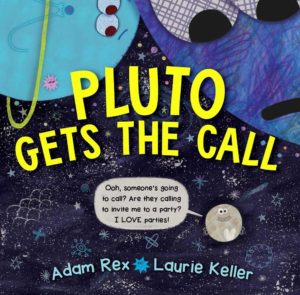 RVC: We’ve interviewed Laurie Keller at OPB and found her—and Arnie!—to be delightful. What was your experience of working with her on Pluto Gets the Call?
RVC: We’ve interviewed Laurie Keller at OPB and found her—and Arnie!—to be delightful. What was your experience of working with her on Pluto Gets the Call?
AR: It was interesting—it wasn’t my first time writing a book I didn’t illustrate, but it was the first time I wrote something for a specific illustrator. I set out there to write a Laurie Keller book, and she made it even more of a Laurie Keller book by adding her signature asides and marginalia. She wrote a ton of extra material that little characters are saying off to the side, so in all fairness I should have to share my author credit on that one with her.
RVC: One of my absolute favorites of yours is Are You Scared, Darth Vader? What’s the story behind how that book came to be?
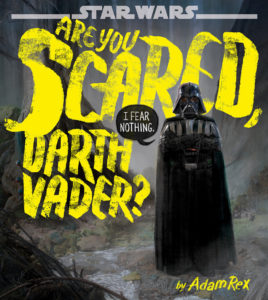 AR: Luck, really! Lucasfilm publishing was toying with the idea of a Star Wars picture book for Halloween, and the creative director there was a fan of my book Frankenstein Makes a Sandwich. He got in touch and asked if I’d like to pitch some ideas. So, I did, and I think Are You Scared, Darth Vader? was the strongest one I pitched.
AR: Luck, really! Lucasfilm publishing was toying with the idea of a Star Wars picture book for Halloween, and the creative director there was a fan of my book Frankenstein Makes a Sandwich. He got in touch and asked if I’d like to pitch some ideas. So, I did, and I think Are You Scared, Darth Vader? was the strongest one I pitched.
RVC: Another fave is School’s First Day of School—such a clever idea. Now I know Christian Robinson is super talented and terrific, but why wasn’t this an “Adam writes and Adam illustrates” book from the start? I can see where many people might think that if you could cook up the peanut butter AND the chocolate, you’d just make the entire Reese’s Peanut Butter Cup yourself every time, if you know what I mean.
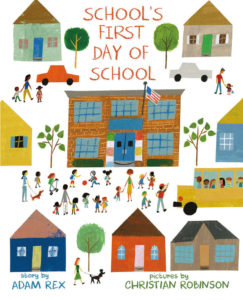 AR: That was my first picture book that I didn’t illustrate, and the truth is I’d been looking for a test case for that scenario for some time. I thought it would be fun to see things from the other side of the fence, and maybe get to work with some of my favorite illustrators in the process. And illustrating SFDoS was an easy job to step away from, because I didn’t think my usual style was well-suited to the manuscript anyway. From the start I was imagining it in a Christian Robinson style. Moving forward I just try to remind myself that I am not the best choice to illustrate every manuscript, so if I don’t feel some compulsion to do it myself, then maybe I should step aside. That frees me up a bit to illustrate a great manuscript from another author, if one should come along.
AR: That was my first picture book that I didn’t illustrate, and the truth is I’d been looking for a test case for that scenario for some time. I thought it would be fun to see things from the other side of the fence, and maybe get to work with some of my favorite illustrators in the process. And illustrating SFDoS was an easy job to step away from, because I didn’t think my usual style was well-suited to the manuscript anyway. From the start I was imagining it in a Christian Robinson style. Moving forward I just try to remind myself that I am not the best choice to illustrate every manuscript, so if I don’t feel some compulsion to do it myself, then maybe I should step aside. That frees me up a bit to illustrate a great manuscript from another author, if one should come along.
RVC: One last question before we wrap up this part of the interview. What’s something upcoming that you’re really excited about or want to promote?
AR: I’m not sure what my next book is going to be, but it might be one I wrote called Digestion: The Musical?! That’s being illustrated right now by Laura Park.
RVC: Sounds quite tasty, Adam. But now it’s time to unleash…THE SPEED ROUND. Mwah-hah-hah! Are you scared, Adam Rex?
AR: Please stop wiggling your wingers at me.
RVC: Your biggest time waster?
AR: Twitter, no question.
RVC: If you could be “trapped” in any of your picture books for a day, which would you choose?
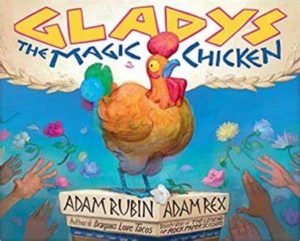 AR: Oh, I wouldn’t mind taking a walk in the candy-colored ancient times of my most recent, Gladys the Magic Chicken (written by Adam Rubin).
AR: Oh, I wouldn’t mind taking a walk in the candy-colored ancient times of my most recent, Gladys the Magic Chicken (written by Adam Rubin).
RVC: Five things we’d see if we checked out your workplace area?
AR: A big paper mâché head of my own head; signed photos of Lou Ferrigno, Noelle Neill, and the guy who played Jaws in the Bond movies; a diorama of a swamp I made for the backgrounds in Are You Scared, Darth Vader?; little sculptures of my own characters that I made to help me draw them; and probably a sleeping dog.
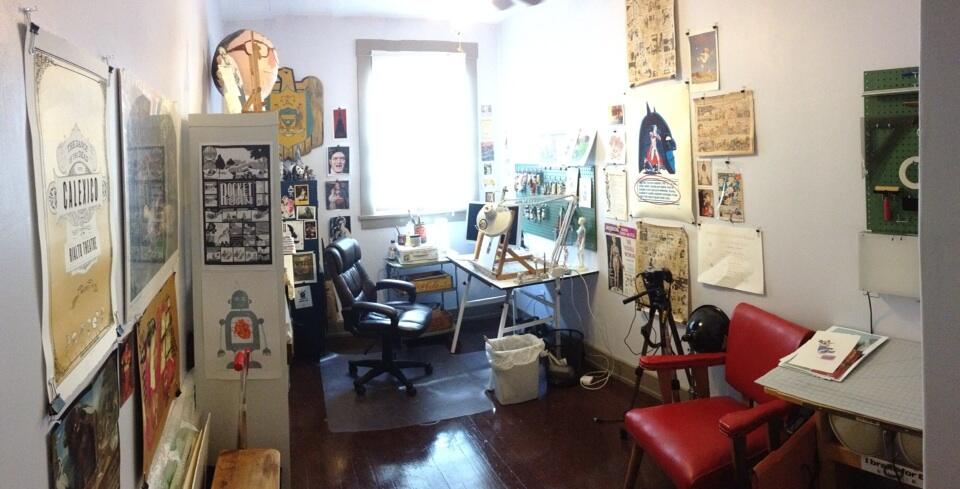
RVC: Best advice you ever received about writing picture books?
AR: Keep your receipts? I can’t think of anything.
RVC: A recent picture book that really got your attention?
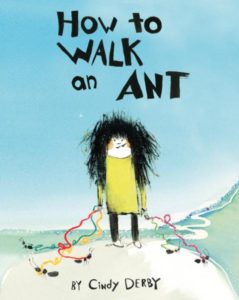 AR: How to Walk an Ant by Cindy Derby.
AR: How to Walk an Ant by Cindy Derby.
RVC: Your proudest moment as an artist?
AR: Probably getting a ribbon at the Arizona State Fair for a drawing of a wizard I did back in 1984. Been chasing that ever since.
RVC: Thanks so much, Adam. It’s been quite the treat!



